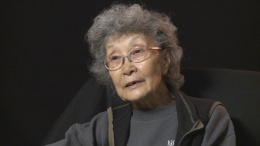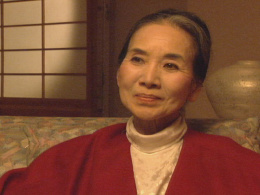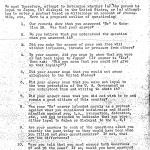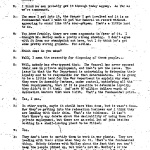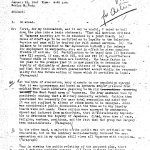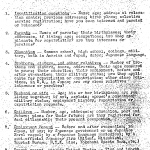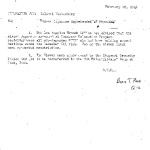Loyalty questionnaire
In 1943, the War Department and the War Relocation Authority (WRA) joined forces to create a bureaucratic means of assessing the loyalty of Nikkei in the WRA concentration camps. All adults were asked to answer questions on a form that become known informally as the "loyalty questionnaire." Responses to this questionnaire were meant to aid the War Department in recruiting Nisei into an all-Nisei combat unit and the to assist the War Relocation Authority in authorizing others for relocation outside of the camps. The registration program provoked a wide range of resistance due to its provocative "loyalty" questions and built resentment among Issei and Nisei over their unconstitutional wartime treatment.
Background and Purpose
The original form for Nisei was entitled, "Statement of United States Citizen of Japanese Ancestry," also titled Selective Service Form 304A. This form was designed with the assistance of the Office of Naval Intelligence (ONI) to determine the likelihood that a U.S.-born Nisei being considered for military service would be loyal to the United States or to Japan. The navy had held a policy since the 1920s of not admitting anyone of Japanese ancestry to serve due to their questions about Japanese American loyalty and Nisei dual citizenship, and despite their participation in developing a form to assess Nisei loyalty, they would continue to refuse Nisei the duration of the war. The ONI believed that they had a series of questions that could accurately predict the loyalty of Japanese Americans, and the War Department wanted a formal means by which they could force Nisei to resolve questions about their citizenship before inducting them into service. The form that became known informally as the "loyalty questionnaire" was created for this purpose and was administered to all adult Nisei men during the late winter and early spring of 1943 who were still incarcerated in the WRA concentration camps as well as to Nisei already serving in the military and to any Nisei processed for induction into the military from 1943–44 living outside of the exclusion zone.
The vast majority of the questions on this form related to identifying family members, past residence, educational levels, language skills, religion, recreational activities, affiliations with associations, family members and/or property in Japan, etc. As Emiko Omori and Eric Muller have pointed out, these seemingly innocuous questions were carefully scored according to categories of "Americanness" and "Japaneseness" that each response indicated. For example, speaking Japanese well, or belonging to a judo or kendo club would result in negative points, but being Christian, or belonging to the Boy Scouts of America would result in points being added.
Questions 25 through 28 asked whether an individual's birth had been registered in Japan, if the individual had renounced his Japanese citizenship, if the individual would serve in combat duty wherever ordered, and finally if he would declare loyalty to the United States and renounce allegiance to the Emperor of Japan. Questions 27 and 28 received the most attention at the time and initiated many questions about the possibility of future draft proceedings, about the War Department's announcement that a segregated combat team was being created for Nisei on a "voluntary" basis without any mention of restoring Nisei rights in exchange for military service, and about the entire process of excluding all Japanese from the West Coast and incarcerating them, including U.S.-born Nisei citizens, without due process of law.
Unintended Consequences
The "loyalty" questionnaire had many unintended consequences, particularly because the WRA simultaneously borrowed the form to initiate its own loyalty investigation of female Nisei and adult Issei without adequate revisions to the form. Question number 27 asked if Nisei men were willing to serve on combat duty wherever ordered and asked everyone else if they would be willing to serve in other ways, such as serving in the Women's Army Auxiliary Corps. Question number 28 asked if individuals would swear unqualified allegiance to the United States and forswear any form of allegiance to the Emperor of Japan. Both questions caused a great deal of concern and unrest. Citizens resented being asked to renounce loyalty to the Emperor of Japan when they had never held a loyalty to the Emperor. Japanese immigrants were barred from becoming U.S. citizens on the basis of race, so renouncing their only citizenship would be problematic, leaving them stateless. Young men worried that declaring their willingness to serve in combat units of the army would be akin to volunteering.
Issei organized their own resistance to registration and succeeded in forcing the WRA to change the form before they would be required to respond. The title of the form had been "Application for Leave Clearance" implying that Issei had voluntarily requested the form. It was changed to read simply "Questionnaire." An alternative question was also provided so that Issei would not risk the possibility of losing all citizenship if they renounced allegiance to the Emperor of Japan and declared loyalty to the United States. On February 12, 1943, the WRA announced that they had revised the loyalty question for the Issei. Issei would be asked simply, "Will you swear to abide by the laws of the United States and take no action which would in any way interfere with the war effort of the United States?"
Since Nisei were being required to fill out their forms as a part of the Selective Service process, their requests for a clarification of their citizenship rights, complaints about the segregated combat team created for Nisei, and discussion about refusing to fill out the form until complaints and demands for a full restoration of citizenship rights were met resulted in threats that Nisei who refused to comply with this Selective Service process would be prosecuted with violating the Espionage Act.
Even though WRA revisions to Issei questionnaires and legal threats against Nisei who refused to comply seemed to crush organized resistance against registration, individuals continued to find ways to express their discontent with not only registration, but segregated combat service for Nisei and the entire program of exclusion, incarceration, and relocation of Japanese Americans regardless of citizenship and with a total disregard for due process of law. Only 1,208 people, fewer than 6 percent of eligible Nisei, enlisted in the military voluntarily from the camps as a whole. This number fell far short of the quota the War Department had set for itself in creating the all-Nisei combat team. It was hoping for at least 2,000 initial volunteers. Seventeen percent of all registrants and approximately 20 percent of all Nisei answered "No" to the loyalty questions number 27 and 28. Most shocking to WRA administrators was the sharp rise in applications for repatriation and expatriation. By 1943, the number of requests had surpassed nine thousand, and most new applicants were citizen Nisei. The trend continued into 1944, when the number of requests topped out at nearly twenty thousand, or 16 percent of the total incarcerated population. Of 19,963 Nisei of military age, only 6 percent had volunteered; approximately 800 of the 1,181 volunteers passed the loyalty tests and their physical examinations and were inducted into the original 442nd . By contrast, 24 percent answered "No" to question 28, for a total of 4,783. An astonishingly high 50 percent answered "No" at Manzanar . By contrast, only 2 percent answered "No" at Minidoka . Overall, 6,700 answered "No" to question 28, and an additional 2,000 qualified their answers. Sixty-five thousand responded with an unqualified "Yes." [1]
Segregation and Renunciation
The WRA, the FBI, the War Department, and even a special Senate committee all tried to explain the results of registration. WRA social scientists argued emphatically that negative responses to the loyalty questions served as a final means of protest against exclusion from the West Coast and incarceration in the WRA concentration camps. Negative responses did not, in their eyes, constitute any concrete proof of disloyalty.
Registration produced many unexpected problems and revealed frustrations and anger among the Nikkei population that could not easily be contained. The War Department had initially planned to house all those who fell into the "disloyal" category in a small isolation facility located in southern Utah near Moab , but it soon became clear that this plan would not work after three thousand individuals at Tule Lake refused to register. As a result, Tule Lake became the new "segregation" center. (See " segregation " for more information).
Congress conducted its own investigation of the results of registration and responded by passing the first law that allowed citizens to renounce their citizenship during wartime. Unlike WRA social scientists who argued strongly that resistance to registration should not be interpreted as proof of disloyalty, congressional representatives who had already been working on ways to strip Nisei of their citizenship interpreted resistance to registration as proof that large numbers of Japanese Americans were loyal to Japan. On July 1, 1944, the President signed Public Law 78-405, otherwise known as the Denaturalization Act of 1944, which allowed citizens to renounce their citizenship. In October 1944, instructions were sent to the camps to help facilitate the process.
One of the most damaging results of the registration crisis was the artificial division of Japanese Americans into "loyal" and "disloyal" categories. Debates continue to rage today about how to shake the stigma and misunderstandings that resulted from the registration crisis and subsequent segregation of the incarcerated population.
For More Information
Hayashi, Brian Masaru. Democratizing the Enemy: The Japanese American Internment . Princeton, N.J.: Princeton University Press, 2004.
Lyon, Cherstin. Prisons and Patriots: Japanese American Wartime Citizenship, Civil Disobedience, and Historical Memory . Philadelphia: Temple University Press, 2011.
Muller, Eric. American Inquisition: The Hunt for Japanese American Disloyalty in World War II Chapel Hill: University of North Carolina Press, 2007.
Omori, Emiko. Rabbit in the Moon . Hohokus, N.J.: New Day Films, 1999.
Weglyn, Michi. Years of Infamy: The Untold Story of America's Concentration Camps . Seattle: University of Washington Press, 1996.
Footnotes
- ↑ Minutes of “Meeting held to discuss results of investigation,” (April 9, 1943), NARA, RG 65, box 81, item 97; Wendy L. Ng, Japanese American Internment During World War II: A History and Reference Guide (Westport, CT: Greenwood Press, 2002), 58-61; Brian Masura Hayashi, Democratizing the Enemy: The Japanese American Internment (Princeton, NJ: Princeton University Press, 2004), 144.
Last updated Aug. 24, 2020, 2:47 p.m..

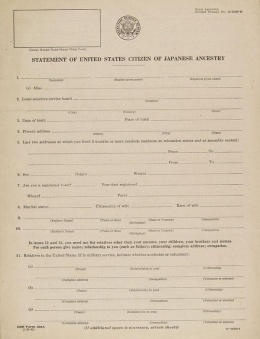 Media
Media

